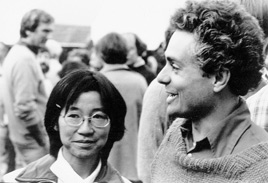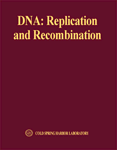|
XLIII: DNA: Replication and Recombination 1978 |
|
|

|
From left: Dr. Louise Chow, Dr. Tom Broker SYMPOSIUM SYNOPSIS LIST OF PARTICIPANTS CONTENTS OF SYMPOSIUM VOLUME PHOTOGRAPHS PUBLISHED VOLUME  |
DNA: Replication and Recombination
May 31 - June 7, 1978
Symposium Synopsis
Organizer: James Watson
Advisors: Tom Broker, Ahmad Bukhari, Arthur Kornberg, Bob Lehman, Charles Richardson, John Cairns, David Dressler, Bruce Alberts, Jun-Ich Tomizawa, Frank Stahl and Charles Radding
"It has not escaped our notice that the specific pairing we have postulated immediately suggests a possible copying mechanism for the genetic material." However, Watson and Crick gave very little thought to the enzymes and cellular mechanisms that would be involved in DNA replication. As Watson pointed out in the foreword to this Symposium volume, he could not remember in 1953, "...any serious discussion of where enzymes would come in." Indeed, in the second DNA paper, Watson and Crick speculated that enzymes might not be needed and that phosphodiester bonds might arise spontaneously between the bases lined up on the DNA template.
Twenty-five years later, Watson made up for his earlier disregard for the biochemical details of DNA replication by holding what was up until then the largest of the Cold Spring Harbor Laboratory Symposia, with 152 presentations and 428 participants. (This at a time when the conference room at Cold Spring Harbor was Bush Auditorium, with a seating capacity of 250 folding chairs!). The meeting began, appropriately, with Arthur Kornberg who reminded the audience that Matt Meselson had shown a cartoon at the 1968 Symposium in which the replication fork was covered discreetly by a fig leaf. Now Kornberg was able to present a diagram of the replication fork with the sites of many of the enzymes and proteins marked. Subsequent sessions dealt with DNA unwinding, replication origins, and then details of what was known of replication in phage, plasmids, bacteria, viruses and eukaryotes.
In contrast to the wealth of biochemical detail on DNA replication in these diverse systems, the sessions on recombination were rather sparse. Frank Stahl remarked on this disparity in his summary and predicted that the meeting, despite (or perhaps because of) the relative backwardness of research on the molecular mechanisms of recombination, would mark a watershed in studies of recombination. The torch was ready to pass from the geneticists to the biochemists, and the fruits of this were evident just six years later, when the whole of the 1984 Symposium was devoted to Recombination at the DNA Level.
Search images: